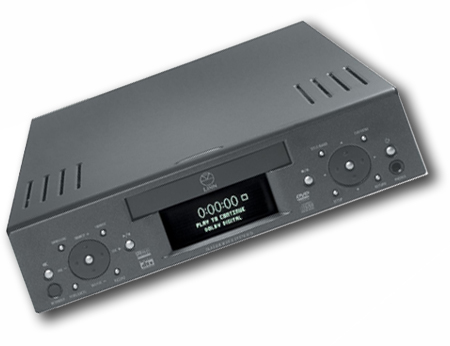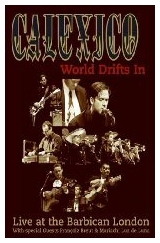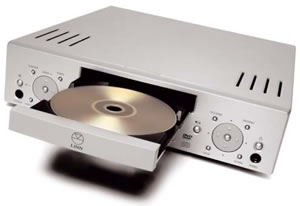You are reading the older HTML site
Positive Feedback ISSUE
16
november/december 2004
linn
Classik Movie Di
as reviewed by Dave and Carol Clark

DAVE CLARK'S SYSTEM: LOUDSPEAKERS ELECTRONICS SOURCES CABLES ACCESSORIES
|
Two PFO Reviewers Take a Closer Look
In which Dave and Carol Clark, my fellow unindicted editorial co-conspirators, spend some quality home theatre time with the Linn Classik Di, and fall in love… with the Linn! (Romance with each other they already got!) - Ye Olde Editor
He says
The Linn Classik Di came into this world as a way to cut down on all that clutters up the audio shelf—in this case the Home Theatre audio shelf. (Actually, the Di is the next generation of the Linn Classik Movie product line, and now allows one to decode a digital signal—cable box, digital TV, etc.—for surround sound and what not, hence the Di designation). What you have here is everything one needs for a very high caliber HT set-up: CD/Progressive-scan DVD player (as well as VCD, MP3 and CD-R), AM/FM tuner (200 presets!), 75 watts times five channels of amplification, and a multi-channel preamp/processor with Dolby Digital, DTS, and Pro Logic II—in a box that measure a mere 3.1 x 12.6 x 12.8 inches (H x W x D), and weighing in at a rather lightweight 11 lbs.
Coming in several classic Linn colors (we got it in basic black, but you can get it in white, silver, blue, and green) the Di can be placed just about anywhere. Easy to use and set-up with a simple and intuitive remote and set-up menu, we were playing movies and music in about 20 minutes.
Yes, there were a few glitches (had a few minutes of head scratching on figuring out how to get the TV audio to be heard—oh, switch it to TV, or hook it up to Aux 1 and go from there!), but the unit offers little to confuse the user as opposed to many of the Asian products that have enough buttons, options, and menus that even Jimmy Neutron would get discouraged! Nothing to really hook up as it is all in one cute box.
I do have a few quibbles. One, the Di uses Deltron speaker connectors, so you may have a problem with your choice of cables. Spades, no go. Bananas, no go. Bare wire, okay go. Terminated with Deltron connectors okay! On the other hand, if you have the banana/spade terminations that unscrew from the threaded part that is soldiered to the cable (as found on my Luminous Audio Renaissance cables), then you are in business, as the threaded end will screw into the Deltron connectors making your present cables still a viable option. If not, get out the snips and be ready for some minor surgery.

Two, the Di has minimal inputs, so you may not be able to connect everything, but since the theme of the product is "less is more" (afterall it is rather small), then perhaps it is time to visit the Goodwill store with some audio cast-offs. As it stood, we were able to connect the TV, Hi-Fi VCR (both are offered dedicated inputs that allow for Dolby Pro-Logic options for sound processing), and a Sony CD-R player (used for copying CDs), leaving you the ability to connect another couple of sources. Not a lot, but enough for reasonable nuts like us.
Three, the Di has an internal fan that runs pretty much non-stop. It's not all that audible unless you feel the need to sit about a foot away from the product when in use—"Gee, the TV looks so much bigger from here!" However, it is just audible enough that I tend to turn the unit off when not in use. Actually, doing this turns the unit to standby mode, but the fan quiets down and one can sleep without worrying about the current energy crisis in California.
She says
While it is true that the fan does run for a long time after the TV is turned off for the night (and this night owl is usually the one to turn it off), it is not distracting during playback—at least, not for me.
He says
We had been using a Toshiba 3109 DVD/CD player, and Adcom GSA-700 processor/amplifier (center and rear), and Adcom 545 amplifier (fronts) with good results. Lots of dynamics and headroom with really decent overall sound and musicality (the front and center speakers are Paradigm LCR350s, the rears are Paradigm 250s, and at the time the sub was an Advent 10—now replaced with a Velodyne DSP-12, which is WAY better!). However, this was simply too many boxes with too many cables, and along with that, the Adcom processor's Dolby Pro-Logic had gone south for the winter—meaning that we had the option of listening to the telly in about a gazillion different surround-sound settings, none of which sounded very great.
So out went the Adcom separates and in came an Onkyo TX SR601 receiver that on paper promised a lot, but in person delivered only headaches. How so, you ask? Like being way too complex to set-up, and being way too difficult to choose which setting for which source (small club, bigger club, small concert hall, bigger concert hall—a gazillion squared and none of them sounded too spiffy.) In addition, when we were watching a DVD, the DD/DTS settings defied any common sense, and offered ho-hum sound as well. All we could figure is that Onkyo felt the need to offer all they could to attract the typical Good Guy shopper for so little money and with so many features to fit into the box, well the money did not end up going where it really mattered—in the sound. It was not that bad, but it never really got us very excited about watching a movie or listening to music on the HT system either. As it stands now, the Onkyo serves as the garage/garden system, where its shortcomings are not the least bit obvious.
She says
I just have to agree with what Dave says. When we set up the Onkyo unit, I think it took the better part of a day, and was very frustrating to boot. The Di entered our lives with almost no hassle. I find it much easier to use than the old set-up we had, primarily because everything you need is on one remote.
He says
Yeah, along comes the Linn Di like a breath of fresh air. Out goes everything (heck it is a all-in-one box after all!) and DVDs have never been more of blast to watch, CDs more fun to listen to (24-bit/96kHZ), and life is just all that much better. The FM radio sounds wonderful too!
Sitting on a Gingko Cloud 10 isolation platform and using an Audience AC cord (latest version) plugged into the Equi-Tech 1.5Q balanced power unit with Audioquest SX S-video cable feeding the Hitachi television, images are as vivid, clean, articulate, detailed, and life-like as my aging eyes can discern. The video section of the Di is stellar (it does use the Silver Disk chip set from the Unidisk player—so go figure) and easily outclasses the aging Toshiba 3109.
 In watching the concert DVD of Calexico (World
Drifts in – Live at the Barbican London), the music is dynamically
propulsive and exquisitely rich in the atmospheric ambiance of a dusty
border town as portrayed in some nameless Quentin Tarantino movie. Featuring
a mixture of jazz-rock-mariachi-TexMex-atmospheric-spaghetti western tunes,
Calexico plays right in your room. As seen through the Di, this is one
performance that is so tactile and involving that either you are there or
they are here. Images are clean and detailed while color tones come across
as natural and yet vivid. Shadows and whites are spot on, making Covertino's
drumming all that more jazzy and Burns singing all that more involving.
Musically, this disc rocks, especially when the Mariachi Luz de Luna comes
out and finishes the last half of the set, combining with Calexcio to meld
into un diablo caliente de venda! This recording does feature a way
too much bottom-end as the stand-up bass has been recorded way too high. The
Di allows one to adjust the sub-output and at a setting of -6, the DVD
sounded just right (this is with the Velodyne set to its lowest setting as
well! Meaning at normal settings the bass boom on this DVD as like WAY too
much to take. What were they thinking?).
In watching the concert DVD of Calexico (World
Drifts in – Live at the Barbican London), the music is dynamically
propulsive and exquisitely rich in the atmospheric ambiance of a dusty
border town as portrayed in some nameless Quentin Tarantino movie. Featuring
a mixture of jazz-rock-mariachi-TexMex-atmospheric-spaghetti western tunes,
Calexico plays right in your room. As seen through the Di, this is one
performance that is so tactile and involving that either you are there or
they are here. Images are clean and detailed while color tones come across
as natural and yet vivid. Shadows and whites are spot on, making Covertino's
drumming all that more jazzy and Burns singing all that more involving.
Musically, this disc rocks, especially when the Mariachi Luz de Luna comes
out and finishes the last half of the set, combining with Calexcio to meld
into un diablo caliente de venda! This recording does feature a way
too much bottom-end as the stand-up bass has been recorded way too high. The
Di allows one to adjust the sub-output and at a setting of -6, the DVD
sounded just right (this is with the Velodyne set to its lowest setting as
well! Meaning at normal settings the bass boom on this DVD as like WAY too
much to take. What were they thinking?).
On other concert DVDs that we had previously found to be of reference quality (visually and sonically) now took on a different appearance (again both visually and sonically). The And All That Could Have Been NIN – Live DVD is one of our all-time favorites (a real reference DVD in terms of the music as recorded and mixed for Dolby Digital by Trent Reznor, and for the color and visual images that the band presents on stage). Via the Di we were shocked at how much better this DVD now came across. Again the shadows and lighting are so vivid and rich that Trent and band are more Memorex than Memorex. Playback is as dynamic as all get out, with deep throbbing bass, guitars that really go crunch, and drums that are recorded so as to pin you to the wall; this concert was now so visceral that we watched almost in fear. It should be noted that NIN is not for the so-faint-of-heart audiophiles, as their DVD clearly was intended to place you at the concert in all its glory. This is a true LIVE DVD in that you are there!
She says
I think the Nine Inch Nails concert DVD is more engaging than attending a live concert. The Di makes the whole thing just that much more enjoyable because the picture is so sharp. This concert appears very atmospheric, and the audio is so dynamic that, as Dave says, it is frightening. I found the same to be true with my other favorite concert DVD, The Cure – Trilogy. The songs on the Pornography set are simply stunning, and all the more engaging on this player. The plaintive qualities of Robert Smith's voice coupled with the tight musicianship of the supporting band are the real stars on this player.
He says
 Ditto for the
Live at the Apollo by Roxy
Music. A true spectacle to experience—or perhaps a spectacular experience—this is one real fun concert, and we're sorry we missed them when they
were in town (but not too sorry at $125 a seat!) But as seen and heard
through the Di—heck, we are there. Again, the Di brings out the music,
colors, details, and visual palpability that makes missing the concert not
such a big deal. Heck, we can enjoy our favorite bands live in concert
without fearing the MAN on the way home—hard to ask for more. By the way,
this concert brings together Ferry, Manzanera, Thompson, and Mackay for an
amazing show that spans the whole Roxy Music catalogue (great song
selection, though a few of my personal favorites were missing). Throw in
some stellar studio musicians, exotic dancers, excellent sound mixing, and
light show and the charged vibe the band creates on stage is easily shared
with the viewer. Same for Bowies new A Reality Tour DVD and Primus
Hallucino-Genetics DVD. With the Linn Di in the mix these are all just too
much fun to put back on the shelf.
Ditto for the
Live at the Apollo by Roxy
Music. A true spectacle to experience—or perhaps a spectacular experience—this is one real fun concert, and we're sorry we missed them when they
were in town (but not too sorry at $125 a seat!) But as seen and heard
through the Di—heck, we are there. Again, the Di brings out the music,
colors, details, and visual palpability that makes missing the concert not
such a big deal. Heck, we can enjoy our favorite bands live in concert
without fearing the MAN on the way home—hard to ask for more. By the way,
this concert brings together Ferry, Manzanera, Thompson, and Mackay for an
amazing show that spans the whole Roxy Music catalogue (great song
selection, though a few of my personal favorites were missing). Throw in
some stellar studio musicians, exotic dancers, excellent sound mixing, and
light show and the charged vibe the band creates on stage is easily shared
with the viewer. Same for Bowies new A Reality Tour DVD and Primus
Hallucino-Genetics DVD. With the Linn Di in the mix these are all just too
much fun to put back on the shelf.
Yeah, great, so we watch too many concerts and need to get out more… what about movies? Well, we don't go out to those either—guess it is the people that keep us home... no it is the Linn Di! But, either Kill Bill (Volume 1 or 2) will really rock you as seen on the Di. You may not like the blood and gore of this homage to "grind-house" exploitation B-movies, but for me, either of these DVDs will get me stuck on the couch for the night. Fun, fun, fun! I just love how Tarantino melded the mix of film genres that he holds so dear. Colors are again so life-like and tangible that you may see more of Uma than you want to, but for me perhaps never enough of Lucy Liu. The skin tones as well as the subtle details as seen in the fabrics, flesh, and whatever else is thrown in your face are so clean and pure in one's ability to differentiate the subtlest of the subtle that you just have to say, "Crap! This machine is good!" It easily reveals differences in S-Video cables allowing us to slightly prefer the Cardas over the Audioquest in terms of overall picture quality and, I know this is going to sound weird, the Cardas is more like analog. It is smoother (less grain) by offering less of the artifacts, that is, it is more like real film and less like digital film. A good example is the scene of Bill and the Bride outside the wedding chapel is shot in black and white. With the Cardas the close-ups of their faces comes across as being more real with less etch and grain. On the other hand the Audioquest is a touch more vivid with slightly more vibrant colors. Either is a winner.
 The action scenes show no slowing or artifacts
and are visually spectacular and fluid as portrayed in either Kill Bill
or
say the Chronicles of Riddick. Sonically, these DVDs really rock on the Di
and are a super sonic thrill ride, especially at relatively loud levels (we
have a smallish room with slightly too-large-for-the-space speakers, so we
really do not need to drive the Linn too hard to get things LOUD). The
bangs, booms, crashes all came across with startling slam and punch. More
than once, we were caught off-guard by a gunshot or punch, and literally
jumped. Take for example the shot that Bill sets the Bride in KB on her
vengeful journey (the one that was supposed to end her life). This is as
real as it gets and makes one reach for the phone to call 911—I mean gee,
talk about close miking! More than once I thought that the Di would clip or
falter when Bill pulls the trigger, but no, the Di launches the bang with
such startling realism that one might soil their pants if the volume level
is set too high.
The action scenes show no slowing or artifacts
and are visually spectacular and fluid as portrayed in either Kill Bill
or
say the Chronicles of Riddick. Sonically, these DVDs really rock on the Di
and are a super sonic thrill ride, especially at relatively loud levels (we
have a smallish room with slightly too-large-for-the-space speakers, so we
really do not need to drive the Linn too hard to get things LOUD). The
bangs, booms, crashes all came across with startling slam and punch. More
than once, we were caught off-guard by a gunshot or punch, and literally
jumped. Take for example the shot that Bill sets the Bride in KB on her
vengeful journey (the one that was supposed to end her life). This is as
real as it gets and makes one reach for the phone to call 911—I mean gee,
talk about close miking! More than once I thought that the Di would clip or
falter when Bill pulls the trigger, but no, the Di launches the bang with
such startling realism that one might soil their pants if the volume level
is set too high.
In watching either movies or concert DVDs, I found nothing to fault in the Linn Di, as everything we threw at it never failed to amuse or entertain us. It never hiccupped, complained, ran out of steam, or belched regardless of the volume levels, countless pauses, starts and stops, or "let's see that again" repeats.
She says
 There is more to life than movies and concerts:
let us not forget my huge collection of wrestling DVDs! I
purchased Ohio Valley Wrestling's March Mayhem 2004 for $19.99 and it would
not play in the Toshiba player at all. I was relegated to watching it on my
laptop. It does play beautifully on the Di, with a picture so sharp you can
feel the bodies hitting the mat! OVW historically offered videotapes of
their weekly wrestling shows (and I have a rather extensive collection of
them), but now that they have access to DVD burning, they are offering
burned DVDs of their shows. So these are not bootlegs. The fact that the Di
plays them is just another reason to love it, in my book. Regular purchased
DVDs also look great; who wouldn't want to see larger than life, clear close
up shots of Triple H and Chris Jericho? When I watched the WWE Raw X special
on DVD, it looked sharper and better than the live telecast! (Ok, so maybe
I'm the only one who wants to see live, sweaty wrestlers close up.)
There is more to life than movies and concerts:
let us not forget my huge collection of wrestling DVDs! I
purchased Ohio Valley Wrestling's March Mayhem 2004 for $19.99 and it would
not play in the Toshiba player at all. I was relegated to watching it on my
laptop. It does play beautifully on the Di, with a picture so sharp you can
feel the bodies hitting the mat! OVW historically offered videotapes of
their weekly wrestling shows (and I have a rather extensive collection of
them), but now that they have access to DVD burning, they are offering
burned DVDs of their shows. So these are not bootlegs. The fact that the Di
plays them is just another reason to love it, in my book. Regular purchased
DVDs also look great; who wouldn't want to see larger than life, clear close
up shots of Triple H and Chris Jericho? When I watched the WWE Raw X special
on DVD, it looked sharper and better than the live telecast! (Ok, so maybe
I'm the only one who wants to see live, sweaty wrestlers close up.)
He says
Musically, I have played enough CDs and
listened to a decent amount of FM broadcasts to say that the Linn Di is
right up there with any sub-grand player or tuner one can purchase.
Actually, it may be more comparable with sub-two-grand players, as it does
have much in common with its higher priced siblings—the Unidisk lineage.
 The Di offers a very well detailed and dynamic sound that is not hard,
harsh, bright, or etched. Sounding warmer than colder, the Di should make
the buyer quite happy by being a bit more forgiving than analytically
revealing. Even on DVDs, I never felt the sound to become hard or etched—it always was clean and well balanced, making whatever we had spinning an
easy experience for long periods at high volume levels. This means that
distortion levels are way down, as are any digital artifacts. The Di also
avoids a tipped-up treble to add a bit more sparkle or false detail and
presence. I will admit that I have not compared the Di to my Cary, so this is
not a definitive declaration of how the Di performs with CDs. My HT rig is hardly comparable to the one I have for 2-channel, so all I can
say is that while I do not listen critically to CDs on the home theatre
system, CDs are quite enjoyable just the same. And especially in that
setting, isn't that what it's all about, anyhow?
The Di offers a very well detailed and dynamic sound that is not hard,
harsh, bright, or etched. Sounding warmer than colder, the Di should make
the buyer quite happy by being a bit more forgiving than analytically
revealing. Even on DVDs, I never felt the sound to become hard or etched—it always was clean and well balanced, making whatever we had spinning an
easy experience for long periods at high volume levels. This means that
distortion levels are way down, as are any digital artifacts. The Di also
avoids a tipped-up treble to add a bit more sparkle or false detail and
presence. I will admit that I have not compared the Di to my Cary, so this is
not a definitive declaration of how the Di performs with CDs. My HT rig is hardly comparable to the one I have for 2-channel, so all I can
say is that while I do not listen critically to CDs on the home theatre
system, CDs are quite enjoyable just the same. And especially in that
setting, isn't that what it's all about, anyhow?
Other quibbles? Well it is not exactly inexpensive—no, it is actually rather pricey at $4900, but you do have to consider this: first, you get a 5-channel amplifier that offers a clean and dynamic 75 watts per channel that is as far from headache inducing as one can get without being syrupy and boring. Second, you get a surround sound processor with the latest chips and configurations that create a believable and startling in-house movie experience. Third, there's an AM/FM rtuner that is quite excellent and comparable to the entry level tuners from Magnum-Dynalab in terms of overall performance. Fourth, you have a DVD player that is as good as I have seen short of the mega-buck stand-alones. Fifth, there's a CD player that is also really quite good (again, it is as musical as you are going to find without going for serious money)—and all this in a box that you can carry in a typical briefcase.
She says
It is more than worth the price of admission.
He says
As a matter of fact, we were so blown away by the Linn that we have dumped the rest of our home theatre gear, and it is now our one and only—but you should have guessed that by now.
What can I say? This is an amazing piece of gear. I have not heard all the home theatre systems out there, nor do I have an HT reference system to compare it to, but you know, I have to say that I really don't care. The Di is grand, and Carol and I are delighted with what it does.
My suggestion is to not take my word for it, but get yourself down to the nearest Linn dealer and take a Classik Di out for a spin. You may just find that your cluttered HT cabinet is a LOT more spacious after you do! We have awarded the Classik Movie Di with our 2004 Brutus Award for being most excellent!
Classik Movie Di
Retail: $4900
Linn
web address: www.linn.co.uk
